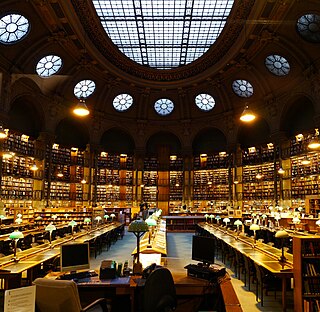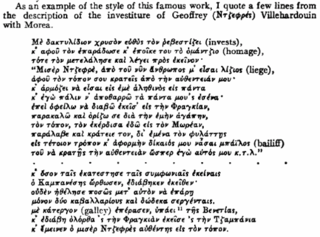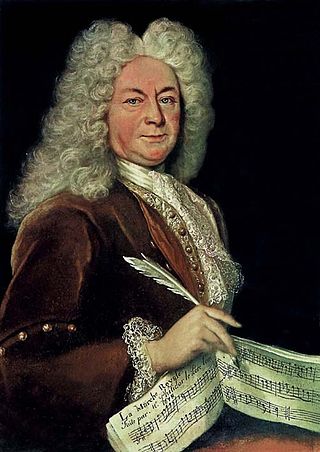
The Bibliothèque nationale de France is the national library of France, located in Paris on two main sites known respectively as Richelieu and François-Mitterrand. It is the national repository of all that is published in France. Some of its extensive collections, including books and manuscripts but also precious objects and artworks, are on display at the BnF Museum on the Richelieu site.

The ouroboros or uroboros is an ancient symbol depicting a serpent or dragon eating its own tail. The ouroboros entered Western tradition via ancient Egyptian iconography and the Greek magical tradition. It was adopted as a symbol in Gnosticism and Hermeticism and most notably in alchemy. Some snakes, such as rat snakes, have been known to consume themselves.

Morea was the name of the Peloponnese peninsula in southern Greece during the Middle Ages and the early modern period. The name was used for the Byzantine province known as the Despotate of the Morea, by the Ottoman Empire for the Morea Eyalet, and later by the Republic of Venice for the short-lived Kingdom of the Morea.

JeanFouquet was a French painter and miniaturist. A master of panel painting and manuscript illumination, and the apparent inventor of the portrait miniature, he is considered one of the most important painters from the period between the late Gothic and early Renaissance. He was the first French artist to travel to Italy and experience first-hand the early Italian Renaissance.
In the Western Church of the Early and High Middle Ages, a sacramentary was a book used for liturgical services and the mass by a bishop or priest. Sacramentaries include only the words spoken or sung by him, unlike the missals of later centuries that include all the texts of the mass whether read by the bishop, priest, or others. Also, sacramentaries, unlike missals, include texts for services other than the mass such as ordinations, the consecration of a church or altar, exorcisms, and blessings, all of which were later included in Pontificals and Rituals instead.

The Aurora consurgens is an alchemical treatise of the 15th century famous for the rich illuminations that accompany it in some manuscripts. While in the last century, the text has been more commonly referred to as "Pseudo-Aquinas", there are as well arguments in favour of Thomas Aquinas, to whom it has originally been attributed in some manuscripts. The translated title from Latin into English is "Rising dawn."

The Froissart of Louis of Gruuthuse is a heavily illustrated deluxe illuminated manuscript in four volumes, containing a French text of Froissart's Chronicles, written and illuminated in the first half of the 1470s in Bruges, Flanders, in modern Belgium. The text of Froissart's Chronicles is preserved in more than 150 manuscript copies. This is one of the most lavishly illuminated examples, commissioned by Louis of Gruuthuse, a Flemish nobleman and bibliophile. Several leading Flemish illuminators worked on the miniatures.

Arethas of Caesarea was Archbishop of Caesarea Mazaca in Cappadocia early in the 10th century, and is considered one of the most scholarly theologians of the Greek Orthodox Church. The codices produced by him, containing his commentaries are credited with preserving many ancient texts, including those of Plato and Marcus Aurelius' "Meditations".

The Paris Psalter is a Byzantine illuminated manuscript, 38 x 26.5 cm in size, containing 449 folios and 14 full-page miniatures. The Paris Psalter is considered a key monument of the so-called Macedonian Renaissance, a 10th-century renewal of interest in classical art closely identified with the emperor Constantine VII Porphyrogenitus (909-959) and his immediate successors.

The Chronicle of the Morea is a long 14th-century history text, of which four versions are extant: in French, Greek, Italian and Aragonese. More than 9,000 lines long, the Chronicle narrates events of the Franks' establishment of feudalism in mainland Greece. West European Crusaders settled in the Peloponnese following the Fourth Crusade. The period covered in the Chronicle was 1204 to 1292. It gives significant details on the civic organization of the Principality of Achaia.

The Tarikh al-fattash is a West African chronicle written in Arabic in the second half of the 17th century. It provides an account of the Songhay Empire from the reign of Sonni Ali up to 1599 with a few references to events in the following century. The chronicle also mentions the earlier Mali Empire. It and the Tarikh al-Sudan, another 17th century chronicle giving a history of Songhay, are together known as the Timbuktu Chronicles.
Codex Parisinus Graecus 456, designated by siglum H, manuscript of Origen's Philocalia and Contra Celsum.
The Chronicle of Cambridge or Cambridge Chronicle, also known as the Tarʾīkh Jazīrat Ṣiqilliya, is a short, anonymous medieval chronicle covering the years 827–965. It is the earliest native Sicilian chronicle of the emirate of Sicily, and was written from the perspective of a Sicilian Christian of the 10th or 11th century. It survives in two versions: a Greek version in two manuscripts and an Arabic version in one. For years only the Arabic text kept in Cambridge University Library was known, but in 1890 a Greek redaction was discovered. The Greek texts are found in the Vatican Library and the Bibliothèque nationale de France. It has been translated into English, Italian and French.

André Danican Philidor the elder [French: l'aîné], a member of the Philidorit family of French musicians and referred to as André Danican Philidor le père after 1709, was a music librarian, instrumentalist, and composer. He is chiefly known as the organizer and principal copyist of what is now known as the Philidor Collection of French Baroque manuscript scores.

The Sacra Parallela is a Byzantine florilegium of quotes in Greek from the Bible and patristic texts used in the instruction of ethics, morals and asceticism.
Muhammad ibn Sa'id al-Tamimi, , known by his kunya, "Abu Abdullah," but more commonly as Al-Tamimi, was a tenth-century physician, who came to renown on account of his medical works. Born in Jerusalem, Al-Tamimi spent his early years in and around Jerusalem where he studied medicine under the tutelage of two local physicians, Al-Hasan ibn Abi Nu'aym, and a Christian monk, Anba Zecharia ben Thawabah. Al-Tamimi possessed an uncommon knowledge of plants and their properties, such that his service in this field was highly coveted and brought him to serve as the personal physician of the Ikhshidid Governor of Ramla, al-Hassan bin Abdullah bin Tughj al-Mastouli, before being asked to render his services in Old Cairo, Egypt. Around 970, Al-Tamimi had settled in Old Cairo, Egypt, and there prospered in his medical field, writing a medical work for the vizier, Ya'qub ibn Killis (930–991), a Baghdadi Jew who came to work in Egypt under the auspices of the Fatimids. He specialized in compounding simple drugs and medicines, but is especially known for his having concocted a theriac reputed as a proven antidote in snakebite and other poisons, which he named tiryaq al-fārūq because of its exceptional qualities.
Pseudo-Simeon is the conventional name given to the anonymous author of a late 10th-century Byzantine Greek chronicle which survives in a single codex, Parisinus Graecus 1712, copied in the 12th or 13th century.

The Kokkinobaphos Master is the conventional name by which modern historians call a master miniaturist active in Constantinople, the capital of the Byzantine Empire, during the 12th century.

The True Black Magic, also known as The secret of secrets, is a pseudepigraphical grimoire or book of spells attributed to King Solomon. It probably dates back to the 14th or 15th century.














